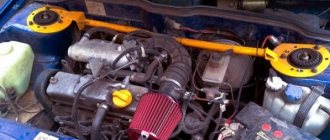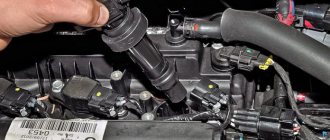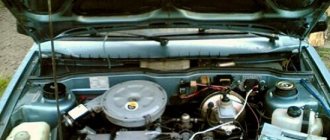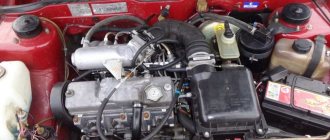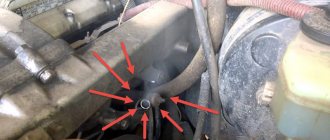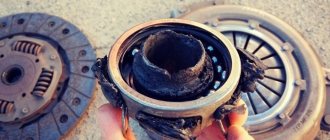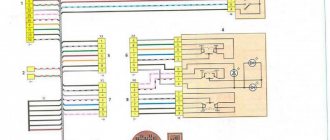When you turn the ignition key of a Priora car, all electronic systems are checked and the check light comes on for a few seconds, this is normal, as it should be. It’s bad when the check light doesn’t light up when you turn on the ignition, which means the check system isn’t working. If the checkbox on a Priora comes on and is lit when the car is started, the owner immediately falls into panic for some reason - at least in most cases. There's no need to panic, but I wouldn't recommend not paying attention. The engine has 16 valves - Priora is equipped with sensors in many components and this may indicate a breakdown. The check light is on on the dashboard of the Priora car, bottom left. Sometimes the check light comes on, you look, and it just drove through a puddle and the knock sensor got wet. The check light is on, it blinks when cold, but there is no need to panic, we need to look for the reasons. Let's make a reservation right away: there are false positives. Read the article and find out all the reasons why the check engine is triggered.
What is a check engine?
“Check Engine” is translated from English as “Check the engine.” On different cars, on the dashboard there is either such an inscription, or simply “Check”, or an engine icon. On the Priora, it is the yellow icon that lights up, resembling an engine in shape. “Check” lights up in two cases:
- Checking the functionality of the sensors. When you turn on the ignition, all the icons on the dashboard light up, indicating that there is a signal from the ECU and the system is ready to operate. After 2-3 seconds of turning on the ignition, the icon will go out.
- Malfunction of the engine operating system. There are several important aspects. Firstly, the ECU does not receive data about all breakdowns: it cannot technically record any mechanical damage. Secondly, the appearance of this icon may be erroneous. But you shouldn’t trust the opinion “it’s all for nothing” - a problem with the engine can grow like a snowball and cost a pretty penny if you ignore it. Regardless of whether the “check” on the Priora is on or flashing, the problem needs to be solved.
Inspection of high voltage wire
Often, the Priora stalls when accelerating due to a malfunction of the ignition system. This is especially true for the condition of the high-voltage wire leading to the spark plug. To inspect it, you will need to remove the tip attached to the spark plug. The structure of a high-voltage wire is as follows: the winding contains the central core of the wire. The tip, which is put on the candle, has a persistent metal penny. The main purpose of this element is to transmit current to the spark plug.
The core of the high-voltage wire should fit as tightly as possible to the “penny” of the steel tip placed on the spark plug. Due to aging, contact between this element and the wire may be lost due to oxidation of the metal. As a result, tripling occurs. The oxidation of the contact is checked as follows: with the second probe of the multimeter, you should touch the central core of the high-voltage wire; if the core of the high-voltage wire burns out along its entire length, then it is possible to identify such a section using a special multimeter tip.
The wire is pierced until the affected area is identified every 5-10 mm. If such a section is detected, it is cut off if the length of the high-voltage wire allows it. Otherwise, it needs to be replaced.
Priora: why the check is blinking or on - the main reasons
The diagnostic connector will help you “talk” to the electronic control unit and find out why the check light is on. Well, before you start diagnosing, check out the list of the most common Priora “errors”:
- Low Oil Level – Low oil levels ultimately lead to increased engine wear. If the oil level turns out to be normal when checked, then it needs to be replaced and the integrity of all Priora components checked. Faulty fuel pump or fuel filter. You can’t always “hear” this, but diagnostics, replacing the filter, and checking the fuel pump will “cure” the breakdown.
- An error in the operation of the exhaust gas system - this is not something to joke about - it is better to start repairs as soon as possible.
- The ignition coil does not produce a spark / the catalytic converter is unstable.
- Wiring problems - high voltage wires can give an erroneous signal to the ECU - "Check" will light up on the dashboard.
- Malfunction of sensors - unfortunately, they very often fail. The “check” lights up due to the fault of the mass air flow sensor (MAF), two oxygen sensors (after the fuel afterburner and in the exhaust manifold), the crankshaft sensor and the camshaft sensor. In frosty weather, the “Check” may light up because three cylinders are turned on first, and then, during normal startup, it does not go away. This is due to the fact that soot particles remain on the contacts - they disappear after a few days.
- False sensor activation due to high humidity
- The engine starts running when cold and the check light comes on.
Tips and reviews from motorists
Judging by the reviews of Priora owners, we can conclude that the following factors may be the reasons for the activation of the engine control warning light:
- In severe frosts, when starting the engine, only three cylinders may turn on, therefore, the check light comes on. After restarting the engine in normal mode, the light may continue to blink for several days. As experts explain, when jamming, a carbon particle can get on the contact and freeze. The spark disappears until the spark plug is cleaned;
- High humidity can also cause the sensor to activate unexpectedly. Usually, after drying the car, the flashing goes away;
- Electronics failure;
- Low quality gasoline. One of the most common reasons is when, due to carbon deposits, the engine starts to stall, and the checkbox reacts to this by lighting up;
- Fuel tank cap is not tightly closed;
- Untimely replacement of spark plugs.
How to reset "Check Engine" on Priora
If the check light is on, then there are two solutions to the problem: fix it, or reset it. The engine icon that lights up is evidence that the ECU has received information about some kind of malfunction in the engine and is informing the driver about it. All errors remain in the computer's memory, so in order to get rid of them without repair, they need to be reset or erased. You can reset a check by following these steps:
- Turn off the engine, secure the car, and open the hood;
- Find the fuse box, in the yellow group, remove F1 (30 Amperes) and wait about 20-30 seconds;
- Put the fuse back and close the hood. Start the engine and check if the signal disappears.
For more than a year now, my check light has been on, I haven’t paid any attention to it, because the car drove great, and the check light can come on for nothing. And just not long ago the car started to malfunction when it was hot. There are many reasons for triple priors: - faulty ignition coils - spark plugs - clogged fuel pump - clogged fuel pump mesh - fuel filter - faulty oxygen sensor - clogged injectors So, to find out the specific reasons, first of all do computer diagnostics. This blog will cover:
1. computer diagnostics (300 rubles) 2. replacing the fuel pump mesh (55 rubles) 3. replacing spark plugs (570 rubles) 4. replacing the fuel filter (215 rubles)
Summary
So, we looked at why the car is tripping. These are not all possible reasons, but they help to accurately diagnose the operation of the motor and find the malfunction.
Priora 2013 mileage 82000 km. In the morning when it’s cold, it starts up fine and works fine, but after 1.5 or 2 minutes it starts to tighten up, and then one of the cylinders switches off completely and the check engine light blinks. Immediately I turn it off and start it again and again it’s fine for 1.5 or 2 minutes, and again it adjusts and the check comes again. And so on several times until the engine warms up to about 20-30 degrees. Diagnostics writes multiple misfires and misfires in cylinders 1,2,3,4. I have already changed two sets of spark plugs, four ignition coils, washed the injectors on the stand, changed the knock sensor, checked the pressure in the fuel rail (3.5 kg/cm2), measured the compression (14.5 kg/cm2) in all cylinders. It all started three months ago, first once every two weeks, then more often, and now every day! Sometimes even when it’s hot, the engine doesn’t start well.
Good afternoon everyone, this is the problem that has arisen here: sometimes when accelerating, this happens, for no apparent reason the check engine light starts blinking, the car stops accelerating at this time, in neutral you can hear the engine revving up and when you press the gas, it picks up speed in jumps. You have to turn it off. , after the factory everything works perfectly. We connected the computer, there is not a single error, everything works fine, what could be the problem? Could it be a misfire? Maybe someone has had this and can help me solve problems, I would be very grateful)
Trouble the engine: why is it dangerous?
This is a rather critical phenomenon, especially if the unit begins to vibrate during acceleration.
Considering that the Lada Priora has been manufactured since 2007, there are often instances where the engine knocks like on an old car 20 years ago. This is an engine running on three cylinders. It may have the latest firmware, but if the engine of a Lada Priora car is running rough and the check light is on, then such a car will not have much life left.
Other reasons for reduced engine performance
The condition of the exhaust system also greatly influences engine power. The fact is that to protect the environment from harmful emissions during operation of the internal combustion engine, catalytic converters are installed in the exhaust.
As a rule, official services offer to replace a worn-out element, but the price of the spare part is very high. For this reason, on many cars in the CIS, the catalyst is simply knocked out, and the control unit is “deceived” by software or other available methods.
Also, when engine power decreases, it is necessary to separately check the installation of the timing belt or chain according to the marks in order to eliminate the possibility of valve timing failure. Sometimes there are situations when the belt can jump one tooth, the chain stretches, etc.
In this case, the synchronous operation of the valve mechanism in relation to the operating cycles of the internal combustion engine may be disrupted. This leads to various failures, unstable operation of the unit and reduced power.
Let us also add that engine wear and certain malfunctions also affect engine power. As a rule, worn-out internal combustion engines with mileage usually lose about 10% of their declared power.
One way or another, any leaks in the combustion chamber will lead to expanding gases breaking out of the cylinder during fuel combustion. This means that the pressure of these gases on the piston will decrease, and the internal combustion engine itself will draw poorly and operate unstably.
Finally, we note that the reason that the car has lost dynamics may not be the engine, but the transmission. In other words, the power unit develops enough power, but it is not fully transmitted to the wheels.
If, when coasting, it is noticeable that the car immediately begins to slow down, then the problem is obvious, the wheels are slightly blocked. If no problems with the brakes are identified, then automatic transmission diagnostics are necessary. It is better to entrust this procedure to experienced specialists by delivering the car to a service center.
Purpose, design features, installation location of the fuel pressure regulator of an injection engine. Signs of RTD malfunctions, checking the device.
As a result, jerks and dips appear when accelerating, and the car jerks in motion during transitional conditions. Causes and troubleshooting.
The most common reasons why an engine does not develop full power. Why do they occur? Common problems with gasoline and diesel engines.
Why the engine may not pick up speed: gasoline engine, diesel unit, car with LPG. Fault diagnosis, useful tips.
When you sharply press the gas pedal, the engine jerks, jerks and dips appear, the car does not pick up speed: the main causes of the malfunction and diagnostics.
Signs of a non-working cylinder (tribbing and vibration) of a diesel engine. Troubleshooting: compression, diesel injectors, glow plugs, injection pump and others.
Supply system
If the Priora engine (16 valves) is tripping, the reasons may be trivial. When there is no flash in the cylinder, perhaps there is simply no fuel there. If it has a normal compression ratio, it is worth diagnosing the power system. You should pay maximum attention to the air filter and the pipe. It is necessary to make sure that the clamps are securely tightened, whether the purifier body itself is intact, and whether there is any air leakage from the outside. Also pay attention to the tubes. They must be tightly secured to the throttle assembly. Fuel leaks, cracks, and broken plastic may indicate that some parts are faulty.
Checking the air filter
If the spark plugs and high-voltage wires appear to be in full working order, and the engine still runs, you should check the air filter. Sometimes this element may simply become clogged, as a result of which less air will flow into the engine, which will cause the analyzed breakdown. According to experts, there is no point in cleaning the air filter from contaminants, because the cost of a new element is quite acceptable, so it is better to simply replace the filter that has become unusable with a new one.
Most often, car owners, after carrying out the above measures, manage to get the engine working and, as you can see, carrying out repair work is quite simple and easy. But if difficulties arise during the work, you can watch a training video lesson on the Internet resource, which is taught by real masters of their craft.
Despite the huge amount of criticism against the Lada Priora, this is one of the most popular cars that have come out of the AvtoVAZ assembly line in recent years. The Priora is equipped with a fairly successful engine with good dynamics, and the interior is very comfortable. And the maximum trim levels offer useful options. But at the same time, from time to time the car brings minor problems to its owners. One of the most popular malfunctions is that the Priora engine (16 valves) is tripping. The reasons for this phenomenon are quite unpleasant. And besides, the motor eventually overheats.
When the driver starts his car in the morning, the engine does not run smoothly as before, but intermittently. At this time, dull sounds are heard from the exhaust pipe. At the same time, a persistent and strong smell of unburned fuel is felt. Vibrations are constantly increasing, and this is fraught with cracks in the pillows. This is how the engine runs when cold.
Diagnostics of spark plugs by plaque
When the engine starts cold or hot, you can check the carbon deposits on the spark plugs. If the coating is white, then this indicates a lean mixture and overheating of the engine. A black tint indicates a rich mixture. In both the first and second cases there are problems with the operation of the electronics. This is either installing new firmware, or replacing the ECU. A normal candle has a brick color. By the way, the engine may stall at idle if the part is damp. This also significantly increases the warm-up time. In addition to the spark plugs, the ignition coil may also be acting up. Priora (8 valves) is equipped with distributor ignition. Overheating of the coil is often observed. You can restore the operation of the motor by simply replacing the element.
Conclusion
The reasons why the engine in a Lada Priora misfires can be determined independently, but not all car enthusiasts manage to eliminate them on their own. Therefore, if the materials provided in the article did not help, or turned out to be too difficult to understand, it is recommended to contact a car service.
Despite the fact that the Lada Priora 16 valves has many defects, this particular model is the most successful of the many varieties of VAZ. Among the most significant advantages are the following:
- dynamism;
- comfort;
- moderate fuel consumption.
However, this model also brings some problems to its owners, for example, the engine is difficult to start or immediately stalls, and the smell of gasoline is clearly felt even inside the cabin. But the most common problem, according to car owners, is that the Priora stalls when cold, as a result of which the engine quickly overheats. That is, if a car owner starts his car, and the engine begins to work with so-called interruptions, while specific sounds are heard from the exhaust pipe and a strong smell spreads from gasoline that has not burned completely, these reasons will indicate that the engine is running cold. You can fix this type of breakdown yourself, but in order for the repair work to be done correctly, experts recommend fixing the breakdown step by step.

